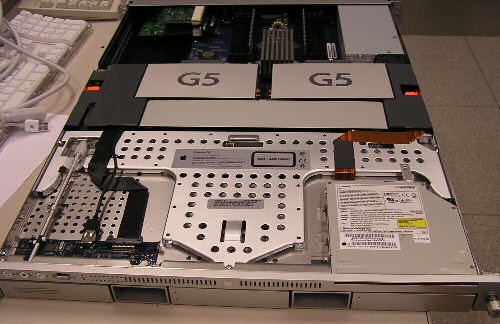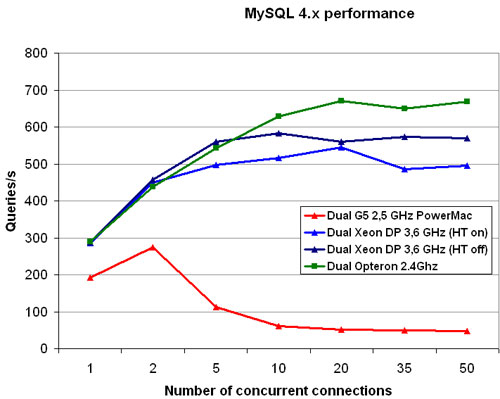No more mysteries: Apple's G5 versus x86, Mac OS X versus Linux
by Johan De Gelas on June 3, 2005 7:48 AM EST- Posted in
- Mac
The G5 as Server CPU
While it is the Xserve and not the PowerMac that is Apple's server platform, we could not resist the temptation to test the G5 based machine as a server too. Installed on the machine was the server version of Mac OS X Tiger. So in fact, we are giving the Apple platform a small advantage: the 2.5 GHz CPUs are a bit faster than the 2.3 GHz of the Xserve, and the RAM doesn't use ECC as in the Xserve.


| Dual G5 2,5 GHz PowerMac | Dual Xeon DP 3,6 GHz (HT on) | Dual Xeon DP 3,6 GHz (HT out) | Dual Opteron 2.4Ghz | |
| 1 | 192 | 286 | 287 | 290 |
| 2 | 274 | 450 | 457 | 438 |
| 5 | 113 | 497 | 559 | 543 |
| 10 | 62 | 517 | 583 | 629 |
| 20 | 50 | 545 | 561 | 670 |
| 35 | 50 | 486 | 573 | 650 |
| 50 | 47 | 495 | 570 | 669 |
Performance is at that point only 1/10th of the Opteron and Xeon. We have tested this on Panther (10.3) and on Tiger (10.4.1), triple-checked every possible error and the result remains the same: something is terribly wrong with the MySQL server performance.
SPEC CPU 2000 Int numbers compiled with GCC show that the G5 reaches about 75% of the integer performance of an equally clocked Opteron. So, the purely integer performance is not the issue. The Opteron should be quite faster, but not 10 times faster.
We checked with the activity monitor, and the CPUs were indeed working hard: up to 185% CPU load on the MySQL process. Notice that the MySQL process consists of no less than 60 threads.

| Concurrency | Dual Powermac G5 2.5 GHz (Panther) | Dual Powermac G5 2.7 GHz (Tiger) | Dual Xeon 3.6 GHz |
| 5 | 216.34 | 217.6 | 3776.44 |
| 20 | 216.24 | 217.68 | 3711.4 |
| 50 | 269.38 | 218.32 | 3624.63 |
| 100 | 249.51 | 217.69 | 3768.89 |
| 150 | 268.59 | 256.89 | 3600.1 |
The new OS, Tiger doesn't help: the 2.7 GHz (10.4.1) is as fast as the 2.5 GHz on Panther (10.3). More importantly, Apache shows exactly the same picture as MySQL: performance is 10 times more worse than on the Xeon (and Opteron) on Linux. Apple is very proud about the Mac OS X Unix roots, but it seems that the typical Unix/Linux software isn't too fond of Apple. Let us find out what happened!










116 Comments
View All Comments
michaelok - Saturday, June 4, 2005 - link
"with one benchmark showing that the PowerMac is just a mediocre PC while another shows it off as a supercomputer, the unchallenged king of the personal computer world."Well, things are a little different when you connect, say, 32768 processors together, i.e. you go from running MySQL to Teradata, so yes, the Power architecture seems to dominate, and the Virginia Tech supercomputer is still up there, at 7th.
http://www.top500.org/lists/plists.php?Y=2004&...
" The RISC ISA, which is quite complex and can hardly be called "Reduced" (The R of RISC), provides 32 architectural registers"
'Reduced Instruction Set' is misleading, it actually refers to a design philosophy of using *smaller, simpler* instructions, instead of a single complex instruction. This is to be compared with the Itanium for example, which Intel calls 'EPIC' (Explicit Parallel Instruction Computing), but it is essentially derived from VLIW (Very Long Instruction Word).
Anyway, nice article, certainly much more to discuss here, such as SMT (Simultaneous Multithreading), (when that is available for the Apple :), vs. Intel's Hyperthreading. We'll still be comparing Apples to Oranges but isn't that why everybody buys the Motor Trend articles, i.e. '68 Mustang vs. '68 GT?
psychodad - Saturday, June 4, 2005 - link
I agree. Recently I read a review which pitted macs against pcs using software blatantly optimized for macs. If you have ever used unoptimized software, you will know it. It is slow, often unstable and not at all usable, especially if you're after productivity.Viditor - Friday, June 3, 2005 - link
IntelUser2000 - "about the AMD TDP number, they never state that its max power, they say its maximum power achievable under most circumstances, its not absolute max power"Not true at all...AMD's datasheet clearly states that it's not only max power, but max theoretical power.
http://www.amd.com/us-en/assets/content_type/Downl...
trooper11 - Friday, June 3, 2005 - link
I think its hard enough comparing a G5 to PC systems. I dont belive there will ever be a 'fair' comparison that satisfies everyone on both sides. There are too few general programs to compare and people will always complain about using or not using optimized apps for either platform. many of the varibles are subjective and the benchmarks to be compared are so heavily debated without a clear answer.I think this was a good attempt, but I gave up trying to 'fairly' compare the two a long time ago. Anyhting that sheds a bit of light is a good thing, but i never expect an end to the contreversy, too many questions that cant be answered.
I would though love to see the addition of dual core amd chips since they are out there and would be serious competition, of course it would fly in server applications. hopefully the numbers for that could be added in a later article.
psychodad - Friday, June 3, 2005 - link
Fascinating. You run these tests using a compiler that Apple does not use (unless it is Yellow Dog) against software generally optimized for x86 architectures and you make conclusions. This makes your data tainted (actually biased) and your conclusions faulty. I would suggest that in fairness you make your tests more "real world" by using the software compiled by compilers that the rest of us nontechnical people use on a daily basis.smitty3268 - Friday, June 3, 2005 - link
Rosyna:Oh, I assumed he was using the Apple version of gcc. If not, then I see what you mean.
crimsonson - Friday, June 3, 2005 - link
This article may be moot by Mondayhttp://tinyurl.com/7ex4v
Garyclaus16 - Friday, June 3, 2005 - link
" Oh and the graph on page 5 doesnt display correctly in firefox. "AND you are using firefox for what reason?...you deserve to view pages incorrectly
Rosyna - Friday, June 3, 2005 - link
smitty3268, that's part of the problem. Almost no one uses GCC 3.3.3 (stock, from the main gcc branch) for Mac OS X development because it really sucks at optimizing for the PPC. On the other hand, OS X was compiled with the Apple shipped GCC 3.3/GCC 4.0.smitty3268 - Friday, June 3, 2005 - link
I think its fair to use the compilers most people are going to be using. That would be gcc on both platforms. As far as autovectorization in 4.0, don't expect very much from it. Obviously it will be better than 3.3, but the real work is being added now in 4.1.I'll join the other 50 posters who would have liked to see at least 1 page showing the G5's performance under linux compared to OSX. That and maybe a few more real world benchmarks. But your article was very informative and answered a lot of questions. It was frustrating that there really wasn't anything done like this before.